30 JANUARY – 8 FEBRUARY 2023
By Jacob Roalef
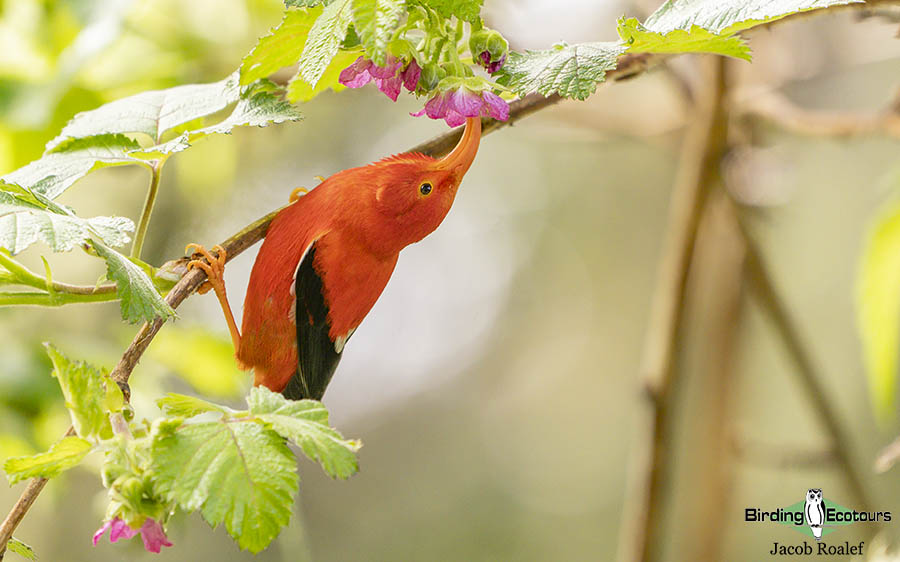
The clown-like I‘iwi stole the show and was the top bird for the trip!
Overview
This ten-day set departure tour of Hawaii began in Honolulu with exploration of the island of O‘ahu and then proceeded to two more of the Hawaiian Islands: Kaua‘i and Hawai‘i (also known as the big island). We visited several fantastic birding locations, including the Ko‘olau Range, the North Shore, Hanalei National Wildlife Refuge, Koke‘e State Park, Pu‘u La‘au, Mauna Kea, an open ocean pelagic and the paradise of Hakalau Forest National Wildlife Refuge.
We recorded many amazing bird sightings, including a variety of endemics, seabirds, and introduced species, giving us an impressive list for the Hawaiian Islands in the short space of ten days. Avian highlights included White Tern, Red-tailed and White-tailed Tropicbirds, Red-footed and Masked Boobies, Red Avadavat, Laysan Albatross, Black Francolin, Chestnut-bellied Sandgrouse, Bristle-thighed Curlew, I‘iwi, ‘Akiapola‘au, ‘Anianiau, ‘Apapane, and an ABA area rarity in the form of Grey-tailed Tattler. We were also successful with the island sweeps of the ‘Amakihi and ‘Elepaio species, plus many others.
A total of 91 bird species were seen, along with a couple of fantastic mammal sightings including a mega pod of Melon-headed Whales, a few lounging Hawaiian Monk Seals, and newborn baby Humpback Whale! Other wildlife highlights were Hawaiian Green Sea Turtle, Flying Fish, and an optional night excursion to see Manta Rays up close and personal in the water. Full bird and mammal checklists can be found at the end of this report.
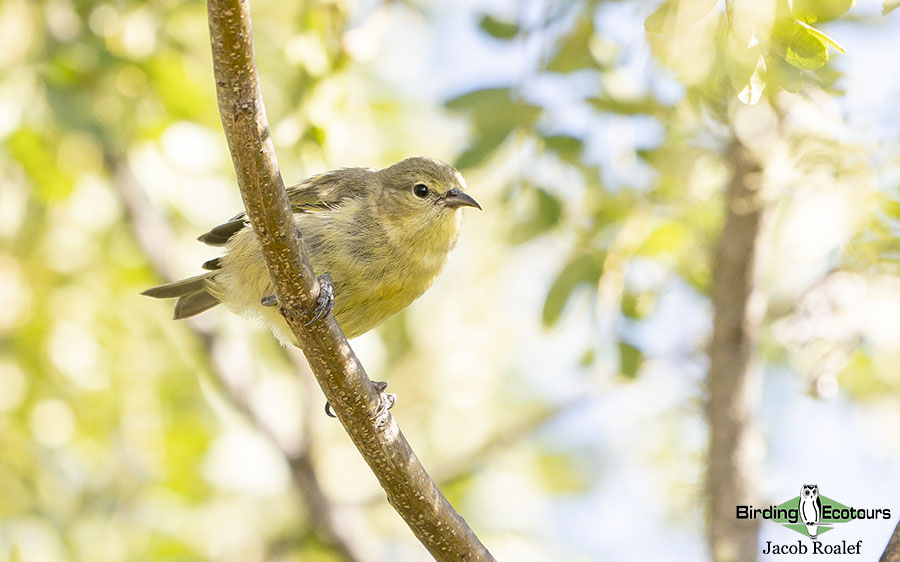
This young Hawai‘i ‘Amakihi was one of three species on the different islands.
Detailed Report
Day 1, 30th January 2023. Arrival and welcome dinner.
All participants arrived in Honolulu and were transferred to the hotel for check-in and a bit of rest after the long journey to the middle of the Pacific. We met at 6pm in the lobby for group introductions and our first dinner together at the lovely hotel restaurant where we managed to note a few of the common species like Spotted Dove, Red-vented Bulbul, and Common Myna. It was then time for sleep in preparation for our first full day of birding.
Day 2, 31st January 2023. Birding O‘ahu – Waikiki to the Ko‘olau Range
After a tasty breakfast at the hotel, we loaded up in the van to begin our Hawaiian birding adventure. We wove our way through the traffic and ascended in altitude towards the Tantalus Ridge. We noted several of the more common species as we drove, like Zebra Dove and Cattle Egret. The view of the city below was spectacular, with a lovely rainbow included, which was only fitting for the rainbow state. It didn’t take long after getting out of the van for us to hear our top target up here . The conditions were a bit challenging, with a constant drizzle of rain, but it did not deter our group and we soon had excellent views of the endemic O‘ahu ‘Amakihi. We descended the mountain and arrived on a busy street in Honolulu where, for some reason, a group of White Terns had decided it was the perfect location for nesting! These were absolutely stunning birds, and such a strange setting to see them, with loud traffic all around. From here we headed off to Kapiolani Park, very close to the famous Waikiki Beach. The trees and grasses here were loaded with notorious species introduced to Hawai‘i, like Common Waxbill, Java Sparrow, Yellow-fronted Canary, Rose-ringed Parakeet, Red-crested Cardinal, and Saffron Finch.
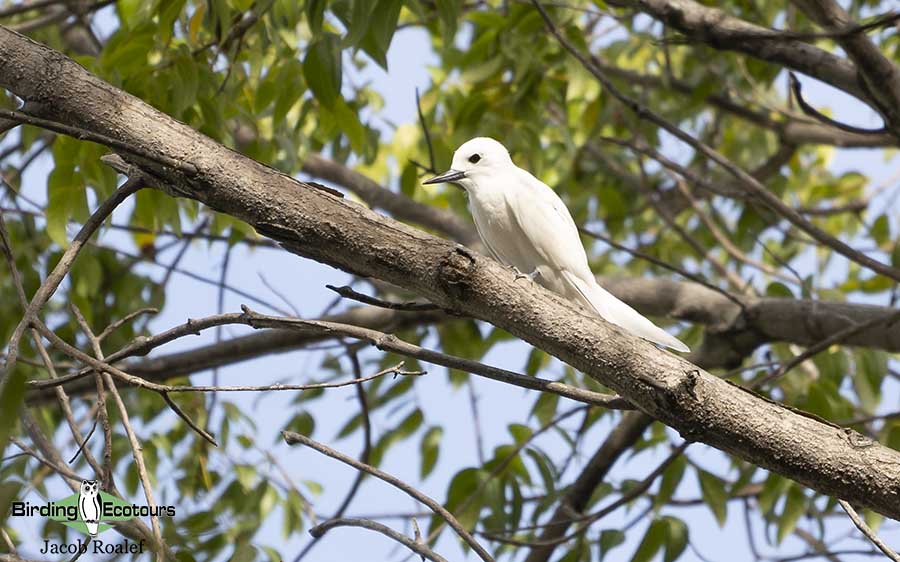
The angelic White Tern was a treat to see along the busy streets of Honolulu.
It was now time for lunch, so we made an order to go and enjoyed some local poke bowls at the Lana‘i Lookout, where we were treated to an incredible show of Red-tailed Tropicbirds flying by and displaying close. We even managed to spot one on a nest in the nearby cliffs. Next up was our other top target for this island – another fantastic endemic. We headed off for a short hike into the nearby valley, equipped with waterbottles and insect repellent. Along the route to our destination, we saw a few more exotic species like Red-whiskered Bulbul, Red-billed Leiothrix, and White-rumped Shama. After a fair bit of searching, we managed to spot the star bird, the endangered O‘ahu ‘Elepaio! We were very lucky to watch a pair of these amazing birds as they constructed their nest. This was the perfect sight to cap off our fantastic day of birding on O‘ahu.
Day 3, 1st February 2023. Birding O‘ahu – The North Shore
With both of our top target species for O‘ahu in the bag we were off to a great start, and ready to tackle a few more target species today. After breakfast we headed to Sandy’s Beach and Makapu‘u Lookout, where we picked up our first Red-footed and Brown Boobies of the trip. Our next stop was the Ka‘elepulu Wetlands, with fantastic views of the endemic Hawaiian Coot, along with the Hawaiian subspecies of both Common Gallinule and Black-necked Stilt. From here we continued our journey around the island and arrived at the Marine Corps Base, which hosted a nice wetlands area allowing us to scope out a locally rare Caspian Tern. We also enjoyed a few close Scaly-breasted Munias, our first for the trip.
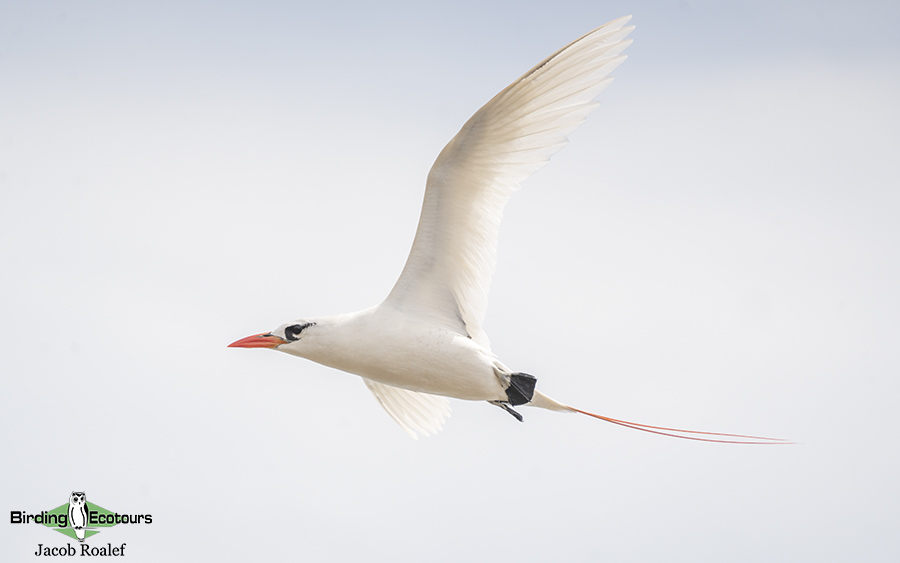
This Red-tailed Tropicbird, along with its friends, put on quite the show for us.
After lunch it was time for a short hike along the Kahuku Golf Course. The course was littered with Pacific Golden-Plovers and Zebra Doves. We eventually reached our destination and were immediately treated to a pair of Bristle-thighed Curlews, a highly-desired species and top target here. We spent some time here and enjoyed these amazing birds before hiking back to the van, where we saw our first Northern Cardinal. Our final planned stop of the day was a brief look at the nearby Kahuku Aqua Ponds, which netted us Sanderling and Ruddy Turnstone, both firsts for the trip. During our drive back to Honolulu, Mandy spotted a small group of Red Avadavats while we were stuck in traffic! A fantastic sighting, as these little birds can be incredibly difficult to find and are highly localized. Everyone managed views and then we settled back into the traffic and continued along to the hotel and dinner.
Day 4, 2nd February 2023. Birding Kaua‘i – Hanalei NWR
Today the morning consisted of a more leisurely breakfast, packing, and a trip to the airport to catch our flight to the next island, Kaua‘i. We landed around noon and began our adventure on island number two. First on the agenda was lunch, which we enjoyed outside and spotted Hawaiian Goose, Great Frigatebird, and Western Meadowlark while we ate. With our bellies full, we headed off to the Princeville Golf Course and experienced the wonders of parenthood up close and personal. We met a local Laysan Albatross father named Larry and watched as he cared for his recently hatched chick. Truly a special moment with an incredible bird. We continued our search of the area and spotted a Snow Goose mixed in with the Hawaiian Geese, and there was a small flock of Chestnut Munias nearby as well.
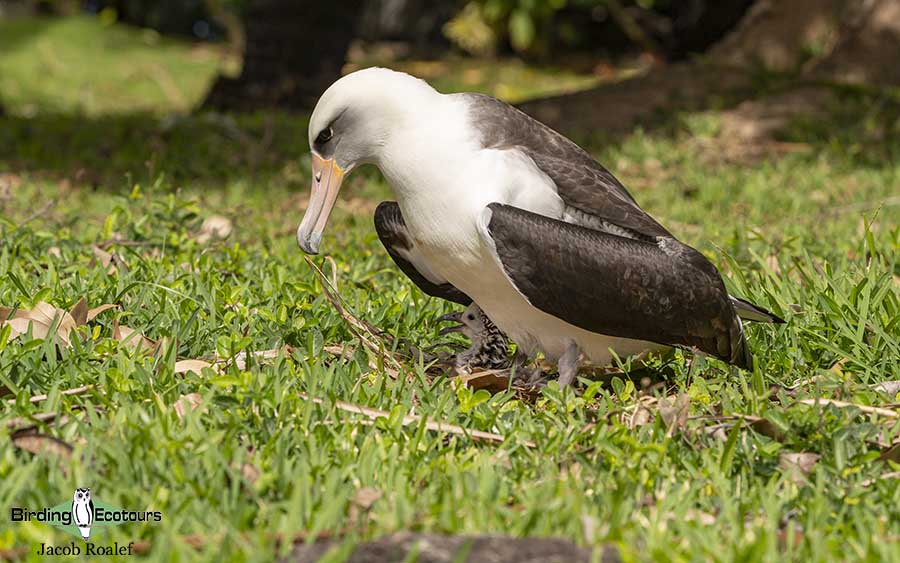
Larry the Laysan Albatross allowed us some views of his parenting skills.
After our lovely time on the golf course, we headed off to Hanalei National Wildlife Refuge to search for our next target. It didn’t take long for us to spot the endangered Hawaiian Duck. As we scoped a few birds from the road, Mandy turned around and all of a sudden saw a tiny duckling at our feet! Surely it was a Hawaiian Duck with no mother around, so it was up to us to save this poor little bird and do our part to help protect this species. We had quite an adventure with our little duckling as we tracked down some refuge employees who would be able to properly care for it and get it the help it needed. It is not everyday that one gets the opportunity to be a part of a rescue team for an endangered species! The day was now winding down, so we finished up with an early evening watch at the Kilauea Lighthouse. Here we enjoyed hundreds of Red-footed Boobies as well as some soaring Laysan Albatrosses and Great Frigatebirds. A few Humpback Whales were also seen way offshore. A great finish to our first day on Kaua‘i.
Day 5, 3rd February 2023. Birding Kaua‘i – Koke‘e State Park
The weather forecast for the morning made it clear that we would be in for a battle against the constant misting rain, as is typical in the wet forests of these islands. Nonetheless, our group was ready for this and not deterred. We headed into Koke‘e State Park, with a quick stop at Waimea Canyon first, to take in the views of what is deemed “The Grand Canyon of the Pacific”. While we were there, the clouds and fog rolled in, and the rain began. We noted a few birds, including Red Junglefowl and Warbling White-eye. We made it up to higher elevations in Koke‘e and managed to find our first endemic species, ‘Apapane. The birding was slow in these conditions, but we still managed to get views of two more endemic species, ‘Anianiau and Kaua‘i ‘Elepaio. We headed back down to the state park lodge to dry off a little and get some warm food and drinks.
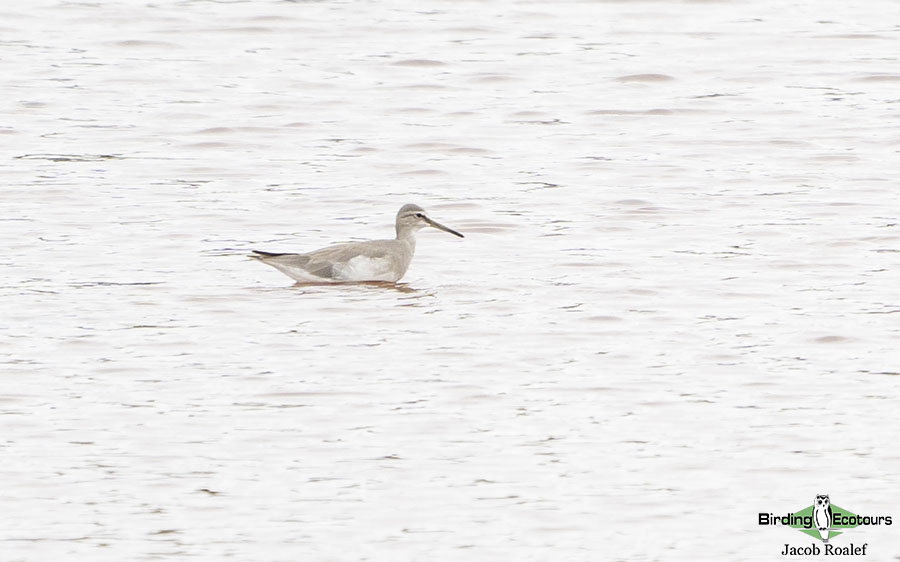
We were excited to find this rare Grey-tailed Tattler to finish the day!
After lunch we decided to venture back to the top of the mountain here, as we were still missing one of the key endemics. While the rain was still misting, we managed to hear and then spot the Kaua‘i ‘Amakihi quickly! This is certainly the toughest of the four target endemic species here, so it was great to get some views of a male. After this we began our journey out of the wet forests and back down to the coastline. Along the way we spotted our first Northern Mockingbird and African Silverbill of the trip, and then reached the Salt Ponds. It wasn’t long before we were onto an interesting bird in the water here. As we got closer, it became clear that we had spotted a rare vagrant Grey-tailed Tattler! An excellent find to go along with the Wandering Tattler, Ruddy Turnstone, Sanderling, and Black-necked Stilts here. We made it back to the hotel where we enjoyed a well-deserved and delicious meal after a very successful day.
Day 6, 4th February 2023. Flight to Hawai‘i, the big island
We all met up this morning for a tasty breakfast at the hotel as usual, but while we ate, we saw something rarer than any bird- a thunderstorm on Kaua‘i! While it often rains on the tropical islands of Hawaii, actual storms with high winds and lightning are incredibly rare . In fact, a few of the locals we spoke to said this was only the third storm here that they’d seen in their entire lives. Of course, this was amazing to see, but unfortunately meant that our morning birding plans had to be cancelled because it was too dangerous in these conditions. Instead, everyone got a nice break mid-trip to catch up on rest, work on photo editing, and enjoy the rooms of this wonderful hotel.
The storm eventually stopped around 11am, right when we needed to check out. We met up in the lobby, left our luggage there with the helpful staff and ventured out for a bit of birding. We decided to grab some lunch and take it to the nearby Poipu Beach Park and enjoy it by the water. In addition to a tasty lunch we enjoyed a few great wildlife sightings, including Hawaiian Green Sea Turtles and a pair of Hawaiian Monk Seals lounging on the beach. We still had a short time left, so we headed over to Opaeka‘a Falls to enjoy the scenic view. Here we spotted a pair of White-tailed Tropicbirds circling the cliffs, and a Red Junglefowl hen jumped into the van and wanted to go with us! From here we headed back to the hotel to gather our luggage and go to the airport to catch our flight to the third and final island of the trip, Hawai‘i (the big island).
Day 7, 5th February 2023. Birding Hawai‘i – Mauna Kea and Waikoloa
Our first morning on the big island started with breakfast and then a trip to the Kealakehe Wastewater Treatment Plant, because no trip is complete without a visit to a water treatment facility. The place was teeming with birds and we added many new species for the trip, including Cackling Goose, Lesser Scaup, Ring-necked Duck, Black Francolin, Ruff, White-faced Ibis, and Yellow-billed Cardinal. After a thorough search of the treatment plant, we made the long journey to Pu‘u La‘au and the dry forests of Mauna Kea. We explored the trails here for a couple of hours and picked up our first two endemics of the island, Hawai‘i ‘Amakihi and Hawai‘i ‘Elepaio. We also caught a few fleeting glimpses of the difficult to see Japanese Bush Warbler. Atunchtime we headed to the town of Waikoloa. Along the way we spotted an Erckel’s Spurfowl up on a fence post, and noted a few Eurasian Skylarks displaying in the distance.
In town we decided to enjoy lunch outside, in the beautiful sunny weather, and we were treated to a small group of Rosy-faced Lovebirds busily flying around and working on nests. After we finished eating, we headed off to the local skatepark, where we searched for a few new species. We managed some fantastic views of Grey Francolin and African Silverbill. We didn’t find our top target, so we drove around the neighborhoods and, not far from the park, we stumbled across the gorgeous Chestnut-bellied Sandgrouse. There were eight birds in total and they were right next to the road, offering us some jaw dropping views. To close out the day we drove up to higher elevations along Kaloko Drive, where we spotted a few Kalij Pheasants, before it began to drizzle and fog rolled in. It was time to head back to the hotel, have dinner, and do our checklists, adding many new trip birds today.
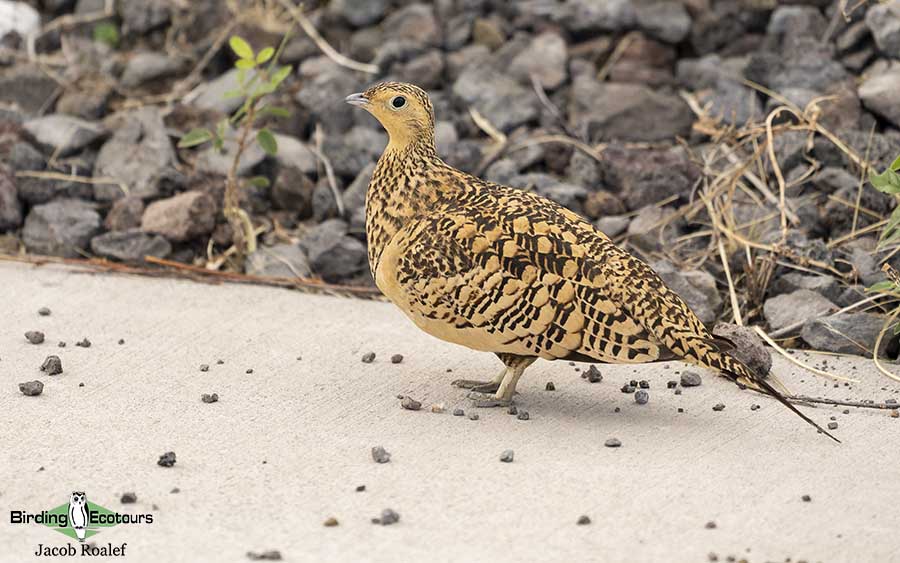
This female Chestnut-bellied Sandgrouse was possibly even more striking than the male!
Day 8, 6th February 2023. Birding Hawai‘i – Hakalau Forest NWR
Today was probably the most anticipated day of the entire trip. One could feel everyone’s excitement at breakfast, as we would get to visit the pristine and amazing Hakalau Forest National Wildlife Refuge, one of the only remaining tracts with native trees and vegetation. Before entering the restricted forest we briefly ventured to higher altitudes and found a small group of Chukars along the side of the road. We then entered Hakalau and were greeted by a few Hawaiian Geese in the parking area. The morning started off with some light rain, as is expected in this wet forest, but thankfully the rainstopped after about 45 minutes and it turned into a stunner of a day, which is rare for this forest. The native birds reacted in turn to the sunshine, and we were soon surrounded by endemic species, with the most numerous being the clown-like I‘iwi and Hawai‘i ‘Amakihi. By the time we sat down for a picnic lunch, we already had views of ‘Akiapola‘au, ‘Oma‘o, Hawai‘i ‘Elepaio, and Hawaiian Creeper. We were serenaded by I‘iwi and ‘Apapane as we enjoyed our lunch, certainly an unforgettable experience. After lunch, we managed to find the final endemic we needed, the Hawai‘i ‘Akepa, as well as some better views of the incredibly unique ‘Akiapola‘au. Our time inside of Hakalau was certainly one for the record books, and it was easy to see why this is the top highlight location of the trip.
On our way out of the forest and back to the main road we drove down the dirt and gravel roads, which contained more open areas, where we spotted the ‘Io (Hawaiian Hawk) perched on top of a distant tree. Thankfully it stayed long enough for us to get scopes on it and enjoy this fantastic endemic species. It was now late in the afternoon, and we began the long journey back to the hotel. Along the way, we got on to a Short-eared Owl and watched as it hunted an open farm field. One could not ask for a better day of birding in Hawai‘i than the one we had today.
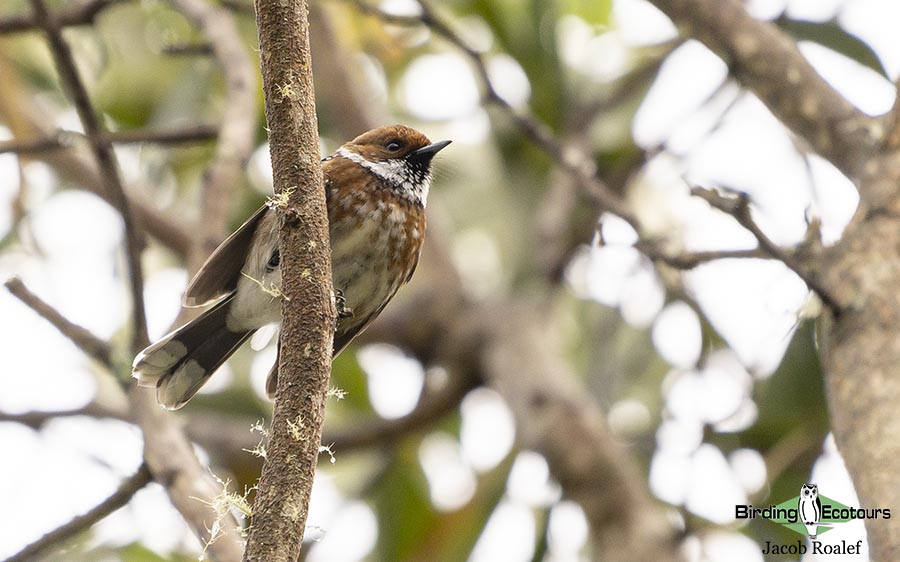
The chestnut color on this Hawai‘i ‘Elepaio was typical in wetter areas.
Day 9, 7th February 2023. Kona Pelagic Birding
We were up early today, loaded up the van and headed down to the boat docks, where we enjoyed some tasty breakfast in preparation for a full day out on the water. Pelagic birding in Hawaii is different from most places, since there are no gulls here to follow the boat and chumming does not work, so the best plan is to find as many bait balls of small fish as possible. We had our game plan and set off soon after dawn. It wasn’t long before we spotted our first of many Wedge-tailed Shearwaters, the default species for the day. The birding was slowand things quickly became a mammal show when we spotted the spout of a Sperm Whale and watched as it dove deep into the water. While this was a very rare sighting here, the top mammal highlight had to be a mother Humpback Whale with her calf of less than a week old. We got to watch as she constantly swam underneath to push the calf up to the surface to breathe, since it was not yet old enough to do this on its own. At the same time, these massive whales were surrounded by a mega pod of the smaller Melon-headed Whale. These smaller whales were certainly annoying the mother Humpback, but it was an unforgettable experience to be surrounded by marine mammals.
The birding aspect took second place on this day, but the action did pick up more in the afternoon when we found several bird piles. Mixed in amongst the groups of Wedge-tailed Shearwaters were Brown Noddy, Brown Booby, Sooty Tern, and Leach’s and Band-rumped Storm-Petrels. Towards the end of the day, we got onto the Hawaiian subspecies of the Black Noddy, which may be a future species split. The birding was certainly excellent, but the whales will forever be the outstanding memory for this day. We finally made it back to shore and we were all exhausted after a long day on the water in the sun, so we had a rest at the hotel to freshen up before our final dinner of the trip.
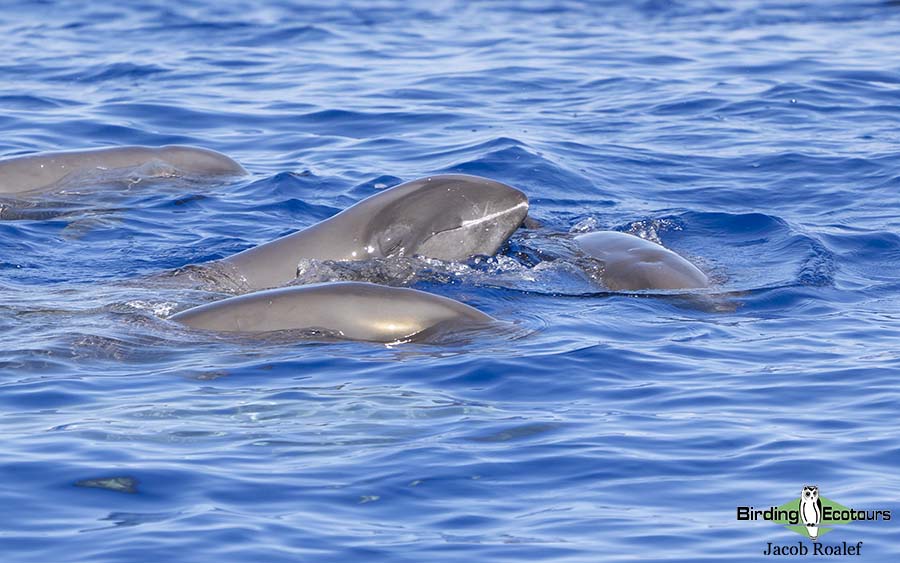
Seeing close to 1,000 Melon-headed Whales was certainly a top highlight!
Day 10, 8th February 2023. Departure day
Today we all enjoyed breakfast together, before saying our goodbyes and heading to the airport. This had certainly been a fantastic trip around the Hawaiian Islands. The previous night, I took count of everyone’s top five favorite species of the trip and the results (in no particular order) were: I‘iwi, ‘Akiapola‘au, Laysan Albatross, Bristle-thighed Curlew, and ‘Apapane.
Bird List – Following IOC (12.1)
Birds ‘heard only’ are marked with (H) after the common name, all other species were seen. Species seen only on the pre-trip day of this trip are marked with (+) after the common name.
The following notation after species names is used to show conservation status following BirdLife International: CE = Critically Endangered, EN = Endangered, VU = Vulnerable, NT = Near Threatened.
| Common Name | Scientific Name |
| Ducks, Geese, Swans (Anatidae) | |
| Nene (Endemic) – VU (Hawaiian Goose) | Branta sandvicensis |
| Cackling Goose | Branta hutchinsii |
| Snow Goose | Anser caerulescens |
| Eurasian Wigeon | Mareca penelope |
| American Wigeon | Mareca americana |
| Hawaiian Duck (Endemic) – EN | Anas wyvilliana |
| Northern Pintail | Anas acuta |
| Ring-necked Duck | Aythya collaris |
| Lesser Scaup | Aythya affinis |
| Pheasants & Allies (Phasianidae) | |
| Wild Turkey (Introduced) | Meleagris gallopavo |
| Common Pheasant (Introduced) | Phasianus colchicus |
| Kalij Pheasant (Introduced) | Lophura leucomelanos |
| Red Junglefowl (Introduced) | Gallus gallus |
| Grey Francolin (Introduced) | Ortygornis pondicerianus |
| Black Francolin (Introduced) | Francolinus francolinus |
| Chukar Partridge (Introduced) | Alectoris chukar |
| Erckel’s Spurfowl (Introduced) | Pternistis erckelii |
| Sandgrouse (Pteroclidae) | |
| Chestnut-bellied Sandgrouse (Introduced) | Pterocles exustus |
| Pigeons, Doves (Columbidae) | |
| Rock Dove (Introduced) | Columba livia |
| Spotted Dove (Introduced) | Spilopelia chinensis |
| Zebra Dove (Introduced) | Geopelia striata |
| Rails, Crakes & Coots (Rallidae) | |
| Common Gallinule | Gallinula galeata |
| Hawaiian Coot (Endemic) – VU | Fulica alai |
| Stilts and Avocets (Recurvirostridae) | |
| Black-necked Stilt (Hawaiian) | Himantopus mexicanus |
| Plovers (Charadriidae) | |
| Pacific Golden Plover | Pluvialis fulva |
| Sandpipers, Snipes (Scolopacidae) | |
| Bristle-thighed Curlew | Numenius tahitiensis |
| Ruddy Turnstone | Arenaria interpres |
| Sanderling | Calidris alba |
| Ruff (Rarity) | Calidris pugnax |
| Wandering Tattler | Tringa incana |
| Grey-tailed Tattler (Rarity) | Tringa brevipes |
| Gulls, Terns, Skimmers (Laridae) | |
| Brown Noddy | Anous stolidus |
| Black Noddy | Anous minutus |
| White Tern | Gygis alba |
| Sooty Tern | Onychoprion fuscatus |
| Caspian Tern (Rarity) | Hydroprogne caspia |
| Tropicbirds (Phaethontidae) | |
| Red-tailed Tropicbird | Phaethon rubricauda |
| White-tailed Tropicbird | Phaethon lepturus |
| Albatrosses (Diomedeidae) | |
| Laysan Albatross | Phoebastria immutabilis |
| Northern Storm Petrels (Hydrobatidae) | |
| Leach’s Storm Petrel – VU | Hydrobates leucorhous |
| Band-rumped Storm Petrel | Hydrobates castro |
| Petrels, Shearwaters, Diving Petrels (Procellariidae) | |
| Black-winged Petrel | Pterodroma nigripennis |
| Wedge-tailed Shearwater | Ardenna pacifica |
| Frigatebirds (Fregatidae) | |
| Great Frigatebird | Fregata minor |
| Gannets, Boobies (Sulidae) | |
| Masked Booby | Sula dactylatra |
| Red-footed Booby | Sula sula |
| Brown Booby | Sula leucogaster |
| Herons, Bitterns (Ardeidae) | |
| Black-crowned Night Heron | Nycticorax nycticorax |
| Western Cattle Egret (Introduced) | Bubulcus ibis |
| Ibis and Spoonbills (Threskiornithidae) | |
| White-faced Ibis | Plegadis chihi |
| Kites, Hawks, Eagles (Accipitridae) | |
| Hawaiian Hawk (Endemic) – ‘Io | Buteo solitarius |
| Owls (Strigidae) | |
| Short-eared Owl | Asio flammeus |
| African & New World Parrots (Psittacidae) | |
| Red-masked Parakeet (Introduced) | Psittacara erythrogenyus |
| Old World Parrots (Psittaculidae) | |
| Rose-ringed Parakeet (Introduced) | Psittacula krameri |
| Rosy-faced Lovebird (Introduced) | Agapornis roseicollis |
| Monarchs (Monarchidae) | |
| Kaua‘i ‘Elepaio (Endemic) – VU | Chasiempis sclateri |
| O‘ahu ‘Elepaio (Endemic) – EN | Chasiempis ibidis |
| Hawai‘i Elepaio (Endemic) – VU | Chasiempis sandwichensis |
| Larks (Alaudidae) | |
| Eurasian Skylark (Introduced) | Alauda arvensis |
| Bulbuls (Pycnonotidae) | |
| Red-whiskered Bulbul (Introduced) | Pycnonotus jocosus |
| Red-vented Bulbul (Introduced) | Pycnonotus cafer |
| Cettia Bush Warblers & Allies (Cettiidae) | |
| Japanese Bush Warbler (Introduced) | Horornis diphone |
| White-eyes (Zosteropidae) | |
| Warbling White-eye (Introduced) | Zosterops japonicus |
| Laughingthrushes & Allies (Leiothrichidae) | |
| Red-billed Leiothrix (Introduced) | Leiothrix lutea |
| Mockingbirds, Thrashers (Mimidae) | |
| Northern Mockingbird (Introduced) | Mimus polyglottos |
| Starlings, Rhabdornis (Sturnidae) | |
| Common Myna (Introduced) | Acridotheres tristis |
| Thrushes (Turdidae) | |
| ‘Oma‘o (Endemic) – VU | Myadestes obscurus |
| Chats, Old World Flycatchers (Muscicapidae) | |
| White-rumped Shama (Introduced) | Copsychus malabaricus |
| Old World Sparrows, Snowfinches (Passeridae) | |
| House Sparrow (Introduced) | Passer domesticus |
| Waxbills, Munias & Allies (Estrildidae) | |
| African Silverbill (Introduced) | Euodice cantans |
| Java Sparrow (Introduced) – EN | Padda oryzivora |
| Scaly-breasted Munia (Introduced) | Lonchura punctulata |
| Chestnut Munia (Introduced) | Lonchura atricapilla |
| Common Waxbill (Introduced) | Estrilda astrild |
| Red Avadavat (Introduced) | Amandava amandava |
| Finches, Euphonias (Fringillidae) | |
| I‘iwi (Endemic) – VU | Drepanis coccinea |
| ‘Apapane (Endemic) | Himatione sanguinea |
| ‘Akiapola‘au (Endemic) – EN | Hemignathus wilsoni |
| ‘Anianiau (Endemic) – VU | Magumma parva |
| Hawai‘i Creeper (Endemic) – EN | Loxops mana |
| Hawai‘i ‘Akepa (Endemic) – EN | Loxops coccineus |
| Hawai‘i ‘Amakihi (Endemic) | Chlorodrepanis virens |
| O‘ahu ‘Amakihi (Endemic) – VU | Chlorodrepanis flava |
| Kaua‘i ‘Amakihi (Endemic) – VU | Chlorodrepanis stejnegeri |
| House Finch (Introduced) | Haemorhous mexicanus |
| Yellow-fronted Canary (Introduced) | Crithagra mozambica |
| Oropendolas, Orioles, Blackbirds (Icteridae) | |
| Western Meadowlark (Introduced) | Sturnella neglecta |
| Cardinals & Allies (Cardinalidae) | |
| Northern Cardinal (Introduced) | Cardinalis cardinalis |
| Tanagers & Allies (Thraupidae) | |
| Saffron Finch (Introduced) | Sicalis flaveola |
| Red-crested Cardinal (Introduced) | Paroaria coronata |
| Yellow-billed Cardinal (Introduced) | Paroaria capitata |
| Total Seen | 91 |
Mammal List
| Common Name | Scientific Name |
| Mongooses (Herpestidae) | |
| Indian Grey Mongoose | Urva edwardsii |
| Earless Seals (Phocidae) | |
| Hawaiian Monk Seal – EN | Neomonachus schauinslandi |
| Rorquals (Balaenopteridae) | |
| Humpback Whale | Megaptera novaeangliae |
| Sperm Whale (Physeteridae) | |
| Sperm Whale – VU | Physeter macrocephalus |
| Oceanic Dolphins (Delphinidae) | |
| Spinner Dolphin | Stenella longirostris |
| Melon-headed Whale | Peponocephala electra |
| Cloven-hoofed Mammals (Bovidae) | |
| Mouflon Sheep | Ovis gmelini |
| Total seen | 7 |
This is a sample trip report. Please email us ([email protected]) for more trip reports from this destination.
